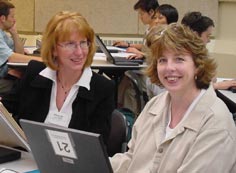 |
|
||||||||||

|
Strategy 9: Giving and Receiving Feedback
In addition to providing meaningful input and maximizing output in the CBI classroom, the teacher needs to ensure that students receive and give feedback on language use and grasp of content (Stoller, 2002). Feedback may be provided in a variety of ways both during instruction and in relationship to assessment. To provide feedback on language use during pair or small group work, a “language facilitator” may be assigned such a role. The language facilitator checks for accuracy, assists with language, and may report back to the class. Depending upon proficiency level, this facilitator may benefit from using a monitor sheet that contains the suggested linguistic forms and possible answers (Fleak, 1992; in Shrum & Glisan, 2000). Corrective feedback techniques can also be used during instruction when appropriate to elicit learner “uptake” and repair (see Lyster & Ranta, 1997) of language. There are several types of corrective feedback. Lyster and Ranta (1997) have found that the most effective feedback techniques are those that require students to reflect on their language use and make attempts to repair their errors. Indeed, reflection is key for language learning (see Tedick, 2003). For an online review of Lyster and Ranta's work see Tedick and de Gortari (1998). The notion of providing feedback is also often associated with summative assessment—that is, students receive feedback on a formal assessment task by means of a rubric and comments from the teacher. However, formative assessment techniques should be used on an ongoing basis to check for language use and content understanding. For example, peer review tasks (which involve the use of checklists; guidelines for peer review) can be powerful tools for extended writing activities or oral presentations. Similarly, self assessment can play an important role. For detailed discussions on peer review and self assessment see Tedick and Klee (1998) and CARLA's Virtual Assessment Center. See also the instructional module on “Assessment for CBI” for more information on assessment principles, techniques, and tools.
References: Fleak, K. (1992). Moving toward accuracy: Using the student monitor sheet with communicative activities. Foreign Language Annals, 25 , 173-178. Lyster, R., & Ranta, L. (1997). Corrective feedback and learner uptake: Negotiation of form in communicative classrooms. Studies in Second Language Acquisition, 19 , 37-66. Stoller, F. (2002, March). Content-Based Instruction: A Shell for Language Teaching or a Framework for Strategic Language and Content Learning? Keynote presented at the annual meeting of Teachers of English to Speakers of Other Languages, Salt Lake City . [online at the CoBaLTT website] Tedick, D. (2003). CAPRII: Key concepts to support standards-based and content-based second language instruction. [online at CoBaLTT website] Tedick, D. J. & de Gortari, B. (1998). Research on error correction and implications for classroom teaching. The ACIE Newletter, 1(3), 1-8 (Bridge Insert). [Online] at /immersion/acie/vol1/May1998.pdf Tedick, D. J. & Klee, C. (1998). Alternative assessment in the language classroom. In G. Stovall Burkart (Ed.), Modules for the professional preparation of teaching assistants in foreign languages. Washington, DC: Center for Applied Linguistics. [Online] at http://www.nclrc.org/essentials/assessing/asindex.htm
|
||||||||||